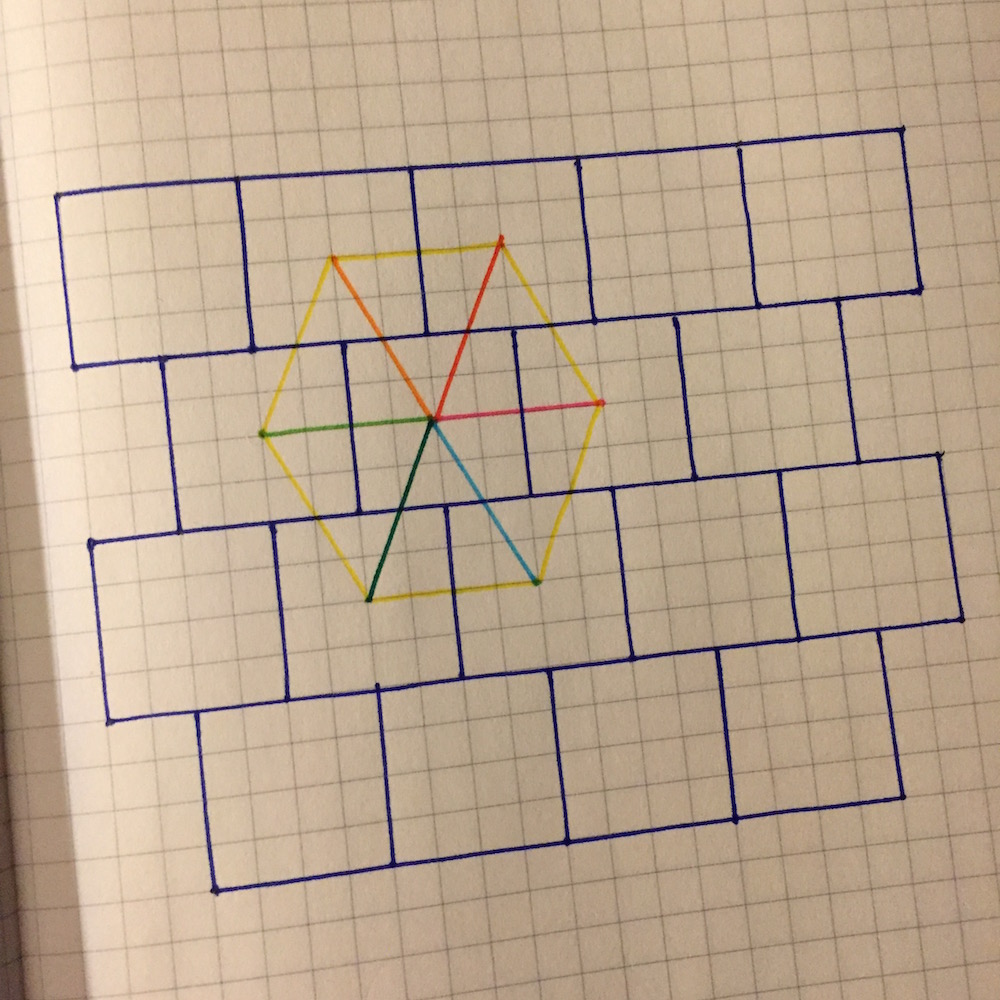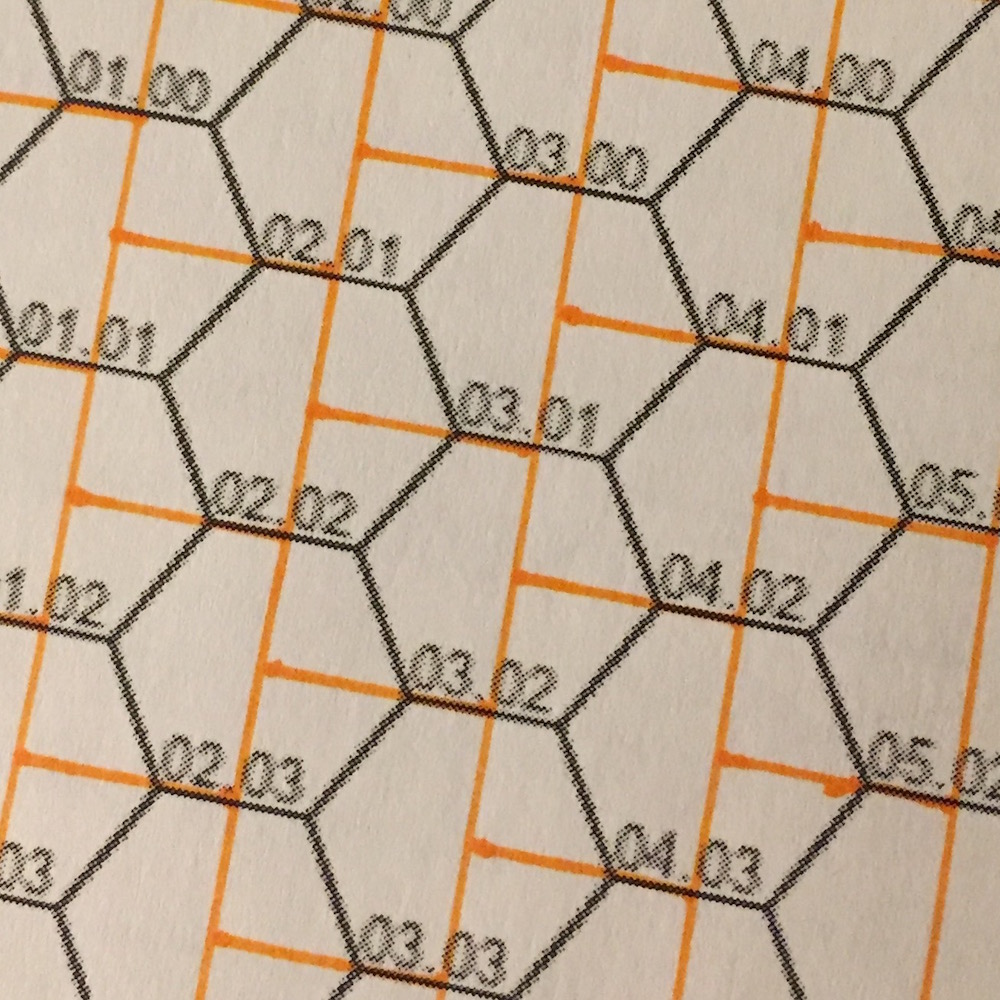Hexes have a cartographic advantage over grids in that the center of a hex is equidistant from the centers all six adjacent hexes. In contrast, on a standard graph paper grid diagonal movement is more efficient than moving in a cardinal direction, assuming a destination other than cardinal-adjacent (that is, other than due north, due south, due east, or due west).
Recently I noticed that squares in a brick configuration are topologically similar to hexes in terms of adjacency. Each brick is adjacent to six surrounding bricks.
Bricks, however, are much easier to sketch than hexes.

To see another way how bricks are similar to hexes, consider the following image and imagine the orange brick overlay moving right until the center of the bricks is superimposed over the center of the hexes.
(This post is groundwork for another idea. To be continued!)


I’ve recently been questioning my love for hexes, because I think unless your players are actually aware of hexes, or the GM is somehow quantizing party movement to hex-centers, they’re much less convenient. Coordinates are harder, sketching is harder, and players aren’t conveniently moving to adjacent hexes, they’re just going “east”, or “north”. This saddens me! On the other hand, I think hexes are great if players ARE saying, “We go northeast to the next hex.”
@Michael
Recently I have been questioning my referee secrecy instinct, which has led me to use hex maps entirely as a referee-facing tool. There are some benefits to this, such as making a smaller area seem bigger and so supporting more play. The wilderness map for my Vaults of Pahvelorn OD&D game was only 6×6 hexes and supported 18 months of real world weekly play.
The player interface was this:
http://www.necropraxis.com/2012/07/08/pahvelorn-player-map/
Which was actually based on blowing up the hex map, printing it out, and then tracing major sites onto an overlay which became the player-facing map. This meant that I could ask players where they wanted to go on the player-facing map and it was always clear exactly which hexes they would need to move through. (Also, I am not sure exactly what you mean by quantizing party movement to hex-centers, but I think I do that; see the solipsistic hexes post linked in one of my other comments.)
That said, I would like to try exposing the hexes directly some time. I think that would make exploring, to uncover the contents of unexplored hexes, extra salient to players.
Some of the old computer and console games used this, rather than hexes. I’ve always called it an offset grid.
@jeffepp
Offset grid is a nice term that is new to me. Thanks!
Yes, this technique was introduced for porting traditional tabletop war-games (almost universally based on hex grids, precisely because this they had equidistance from the center) back in the 80s, I believe.
I suggest you check out this https://gamedev.stackexchange.com/questions/54027/why-dont-we-use-octogonal-maps-instead-of-hexagonal-maps for more discussion about alternatives to hex-based mapping.
You could always have a normal square grid, with diagonal movement being 150% (i.e. one and a half times) that of horizontal or vertical movement. But that just doesn’t have the nostalgia of a hex map like Darlene’s for Greyhawk or the one for the Grand Duchy of Karameikos in the Expert set.
@John L
I have minimal nostalgia for hexes beyond memories of browsing the maps in the back of the Rules Cyclopedia. (I started playing D&D with second edition.) In fact, I never used hexes systematically until I discovered the online trad gaming community around 2011.
For me, the major benefit now of using hexes is having a nice abstract geographic container for adventure sites and having a simple categorical metric for travel (generally, I do one day of wilderness travel = move one hex or do one thing such as search for hidden features). In this way, hexes end up being a lot like amorphous dungeon rooms, each with six exits. Running wilderness exploration like this is so fluent for me that I doubt I will ever shift to any other approach.
See also:
http://www.necropraxis.com/2013/04/10/solipsistic-hexes/
And the rules for wilderness turns in the Hazard System:
http://www.necropraxis.com/hazard-system/
From what I know Octagonal maps were used only by International Team (despite the name it was an Italian publisher) for a couple of their Napoleonic titles. Here is an example: https://boardgamegeek.com/boardgame/6125/austerlitz (I never owned or played it so I cannot say if they had special rules about movement, though).
The 150% “distortion” was precisely the reason to go “hex” for war-games: moving “diagonally” would give an excessive boost to unit mobility (even more so in case of roads which usually costed less to traverse).
If you want to preserve a minimum of tactical element to your game this is not really acceptable, I think.
Brendan, it is always wonderful to have a post from you.
This is a simple explanation for what might have been a complicated idea in the hands of anothe blogger. Finish it!
@Scott
Thanks!